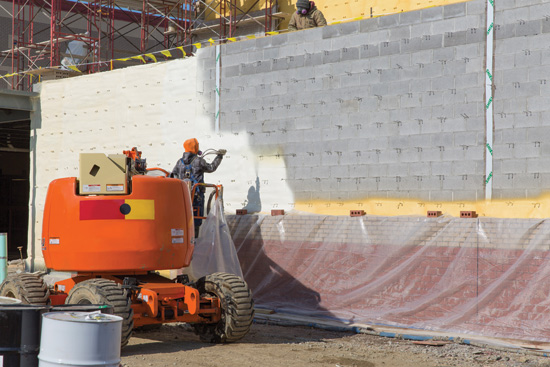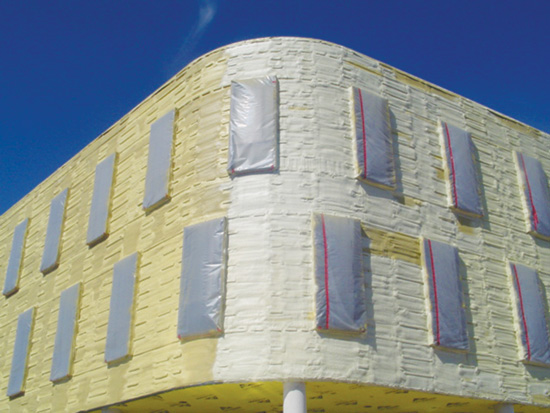Continuous Insulation: Spray Foam Compared to Rigid Boards
Expanded foam (EPS) characteristics. EPS foam insulating sheathing has become a fairly well-known standard product. As an exterior insulating sheathing material, it is non-structural and has been used both above and below grade in addition to roof, floor, and ceiling installations. Different densities are available that can provide the R-value required to meet energy codes.
Extruded foam (XPS) characteristics. XPS is manufactured in a continuous extrusion process that produces a homogeneous closed cell cross section, whereas EPS is manufactured by expanding spherical beads in a mold, using heat and pressure to fuse the beads together. The documented results of this difference in manufacturing process indicate that XPS is more moisture resistant than EPS and holds its R-value better at lower mean temperatures when water is present.
There is a third common type of rigid insulation board used in buildings, namely polyisocyanurate or “polyiso” insulation. Polyiso is a closed-cell, rigid foam board insulation made from a plastic that is similar to, but still different from, polyurethane. It is commonly manufactured into rigid insulation boards consisting of a foam core sandwiched between two face sheets. These face sheets can be composed of organic or inorganic materials with foil or paper and fiberglass being the most common. It is widely used in residential and commercial markets most typically for flat roofing applications.
Spray Foam Insulation
In contrast to rigid, pre-manufactured boards, spray foam is field-applied insulation used in a range of settings, including industrial operations, heating plants, and buildings. Typically, this sprayed insulation is polyurethane based which can be formulated in different densities with different characteristics. Low-density foam weighs about 0.5 pound per cubic foot when installed. It is typically an open cell product which remains somewhat flexible in place and achieves R-values comparable to fibrous insulation. Medium-density foam, as the name implies, is heavier than low-density spray foam, coming in at about 2 pounds per cubic foot, or roughly four times heavier than low-density material. Its other defining characteristic is the closed cell nature of the insulation when mixed. Since it becomes a series of small bubbles (cells) of trapped insulating gas (a blowing agent), the thermal performance is directly enhanced, resulting in an over 70 percent increase in R-value compared to traditional insulation. R-values are possible up to R-7.1 per inch for closed cell spray foam compared to 3.7 per inch for open cell.


Photos courtesy of ICYNENE, Inc.
Rigid foam boards (top) come in standard sizes and need to be cut and fit into wall assemblies. Spray foam insulation (bottom) is directly applied to the appropriate surface of the wall assembly in the quantity needed.
The make-up of medium-density insulation also allows it to serve as a full air barrier, eliminating the need for a separate product to perform that function. In fact, according to the Air Barrier Association of America (ABAA), many medium-density spray foam insulations are classified as air barrier materials and are the key component in tested air barrier assemblies. Further, in terms of water vapor permeance, it tests as a class II vapor retarder, meaning it has low water vapor permeance. Hence, it has been used in wall assemblies, including stud cavities, to meet the code requirements for a vapor retarder. Additionally, the material serves as a full water resistant barrier as defined in building codes. Collectively, this means that medium-density, closed cell, spray foam insulation provides the performance of four products in one—insulation, air barrier, vapor retarder, and water-resistive barrier. This combination of traits means it not only has the potential to save time and money during construction, it also significantly reduces air leakage, minimizes water and moisture transfer, and optimizes energy efficiency.
Design and Performance Considerations
With an understanding of the basic types of foam insulation products available and their characteristics, our focus can now turn to the selection of those products for use in buildings, specifically in exterior wall assemblies. There are some general design considerations that should be addressed as follows.

Photo courtesy of ICYNENE, Inc.
Spray foam insulation can be applied to curved and irregular surfaces while also readily sealing around other wall features such as windows.
Continuity Along Wall Shape
Not all buildings are designed to be rectilinear, and even those that are often have some unique or irregular conditions along the walls. Rigid insulation boards are necessarily rectilinear and don't bend or adapt easily to irregular conditions in a wall assembly. Therefore, they may not be a practical or realistic choice for certain buildings where continuity of the insulation is a key design criteria. By contrast, spray foam insulation conforms directly to the surface it is being applied to regardless of shape, geometry, or irregularities. That means that it fully covers and seals over the underlying construction to provide a truly continuous, uninterrupted insulation layer and protective barrier. It also means that buildings designed with intentional curves, domes, arches, angles, or other non-rectilinear shapes no longer need to suffer from lower performance because of limitations from other insulation types. A curved surface for example would be very difficult if not impossible to cover properly with rigid foam board insulation. Mineral fiber batts or blankets do curve and may be used in wall cavities including curved surfaces. However, they do not provide the same performance in terms of insulation level per inch, water resistance, or air resistance. Spray foam insulation would provide excellent performance in all of those areas since its characteristics are not limited or influenced by the shape of the building.









